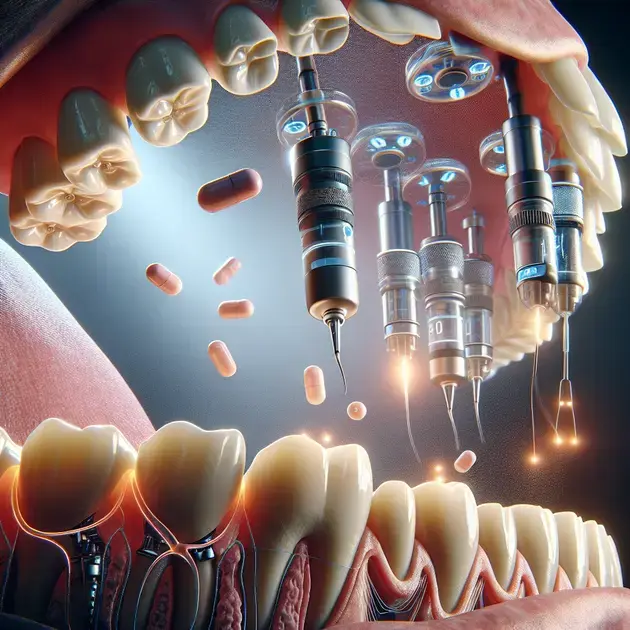When it comes to tackling periodontitis, finding effective medication is crucial for overall oral health. Understanding the best treatment options can make a significant difference in managing this common condition. In this article, we will dive into what you need to know about effective medication for periodontitis, shedding light on the latest developments and recommendations.
Periodontitis, a severe form of gum disease, affects millions of people worldwide and can lead to serious complications if left untreated. With advancements in dental research, new medications and treatment approaches are constantly being explored to provide better outcomes for individuals dealing with periodontitis. Stay informed about the most effective medication options available to combat this oral health issue.

Understanding Periodontitis Treatment
Periodontitis is a serious gum infection that can damage the soft tissue and destroy the bone that supports your teeth. It is important to seek treatment for periodontitis to prevent further complications and maintain good oral health. Here is a step-by-step guide to understanding the treatment options for periodontitis:
Evaluating the Severity of Periodontitis
The first step in treating periodontitis is to undergo a comprehensive evaluation by a periodontist. This evaluation may include a visual examination, periodontal probing, dental x-rays, and other diagnostic tests to determine the extent of the infection and damage to the gums and bone.
To find more information about periodontitis evaluation, you can visit the American Academy of Periodontology’s website and search for their guidelines on diagnosing and classifying periodontal diseases.
Non-Surgical Treatments for Periodontitis
In many cases, non-surgical treatments such as scaling and root planing (deep cleaning) can effectively remove the plaque and tartar buildup that is causing the gum infection. This procedure may be done under local anesthesia to ensure your comfort.
To learn more about scaling and root planing for periodontitis, you can download the “Healthy Gums” app from the App Store, which provides detailed information and video tutorials on this treatment option.
Surgical Options for Advanced Periodontitis
If non-surgical treatments are not sufficient to address advanced periodontitis, surgical interventions such as flap surgery, bone grafts, or soft tissue grafts may be recommended. These procedures aim to reduce pocket depths, regenerate bone, and restore gum tissue.
To explore more about surgical options for advanced periodontitis, you can access the Mayo Clinic’s website and read their patient resources on periodontitis treatment, which include descriptions of various surgical procedures.
Exploring New Medication Options
Recent advancements in periodontitis medication have opened up new possibilities for treating gum infections more effectively. Here is a detailed look at the latest medication options available for periodontitis:
Antibiotics for Periodontitis Treatment
In some cases, antibiotics may be prescribed to help control the bacterial infection causing periodontitis. Antibiotics can be taken orally or applied directly to the gum pockets to target the specific bacteria responsible for the infection.
To find out more about antibiotics for periodontitis treatment, you can visit the Centers for Disease Control and Prevention (CDC) website and access their guidelines on antibiotic use in dentistry.
Anti-Inflammatory Medications for Gum Infections
Anti-inflammatory drugs such as NSAIDs (nonsteroidal anti-inflammatory drugs) may be recommended to reduce gum inflammation and alleviate pain caused by periodontitis. These medications can help manage the symptoms of the infection.
To learn about the use of anti-inflammatory medications for gum infections, you can consult the British Society of Periodontology’s online resources, which provide information on managing periodontitis symptoms.
Latest Developments in Periodontitis Medication
Ongoing research and clinical trials are constantly contributing to the development of new medications and treatment approaches for periodontitis. Stay informed about the latest developments in periodontitis medication with these resources:
Bioengineered Therapies for Periodontitis
New bioengineered treatments, such as growth factors and tissue engineering techniques, show promising results in regenerating damaged gum tissue and bone affected by periodontitis. These innovative therapies aim to restore oral health and function.
To read more about bioengineered therapies for periodontitis, you can access the National Institute of Dental and Craniofacial Research (NIDCR) website and explore their research updates on regenerative medicine in dentistry.
Targeted Drug Delivery Systems
Advancements in targeted drug delivery systems are enabling more precise administration of medications to the affected areas in the gums. This approach helps improve the effectiveness of periodontitis medication while minimizing side effects.
To delve into targeted drug delivery systems for periodontitis, you can refer to the Journal of Clinical Periodontology’s publications, which cover recent studies on innovative drug delivery methods in periodontal therapy.

Exploring New Approaches to Periodontitis Treatment
In recent years, the field of periodontitis treatment has seen significant advancements, with researchers and clinicians exploring new approaches to tackle this prevalent oral health issue. One novel approach that has shown promise is the use of targeted antimicrobial therapy to combat the bacteria responsible for periodontal disease. By specifically targeting the pathogens involved in the development of periodontitis, researchers hope to achieve more effective and efficient treatment outcomes.
Another innovative approach being explored is the use of probiotics in the management of periodontitis. Probiotics are beneficial bacteria that can help rebalance the oral microbiome, potentially reducing inflammation and promoting gum health. By incorporating probiotics into periodontal treatment regimens, researchers aim to explore new avenues for improving patient outcomes and preventing disease progression.
Furthermore, advancements in regenerative medicine have opened up new possibilities for treating periodontitis. Techniques such as tissue engineering and growth factor therapy hold the potential to regenerate and repair damaged gum tissue, leading to improved periodontal health. By exploring these regenerative approaches, researchers are uncovering new ways to promote tissue repair and enhance the overall success of periodontal treatment.
Overall, the exploration of these new approaches to periodontitis treatment signifies a shift towards more personalized and targeted strategies for managing this chronic oral health condition. By incorporating innovative therapies and techniques, clinicians are better equipped to address the underlying causes of periodontitis and provide patients with tailored treatment plans that prioritize long-term oral health.
Innovations in Medication Delivery for Periodontitis
When it comes to treating periodontitis, the delivery of medications plays a crucial role in ensuring effective and targeted therapy. Innovations in medication delivery systems have revolutionized the way periodontal medications are administered, enhancing their efficacy and patient compliance. One key innovation in this field is the development of localized drug delivery systems, such as dental implants or biodegradable gels, that can directly target the affected gum tissue.
Another innovative approach is the use of nanotechnology in medication delivery for periodontitis. Nanoparticles can be engineered to encapsulate antimicrobial agents or growth factors, enabling targeted and controlled release at the site of infection. By leveraging the unique properties of nanoparticles, researchers are exploring new ways to improve the efficiency of periodontal medication delivery and enhance treatment outcomes.
In addition, advancements in drug-eluting devices, such as dental strips or microspheres, offer novel solutions for delivering medications directly to the periodontal pockets. These devices provide sustained release of therapeutic agents, ensuring prolonged exposure to the affected area and maximizing the drug’s effect. By incorporating these innovative medication delivery systems, clinicians can optimize the treatment of periodontitis and improve patient outcomes.
Overall, the continuous innovations in medication delivery for periodontitis demonstrate a commitment to enhancing the efficacy and precision of periodontal treatment. By leveraging new technologies and approaches, researchers and clinicians are paving the way for more effective and patient-friendly strategies for managing this prevalent oral health condition.
Enhancing Periodontitis Care with Targeted Localized Medication
Targeted localized medication has emerged as a promising approach to enhancing periodontitis care, offering precise and efficient delivery of therapeutic agents to the affected gum tissue. By focusing on localized treatment, clinicians can minimize systemic side effects and maximize the concentration of medications at the site of infection, improving the overall efficacy of periodontal therapy.
One key advantage of targeted localized medication is its ability to overcome the limitations of traditional systemic drug administration. By delivering medications directly to the periodontal pockets or affected tissue, clinicians can achieve higher drug concentrations and better outcomes with lower doses, reducing the risk of adverse effects and promoting patient comfort.
Furthermore, targeted localized medication allows for personalized treatment regimens tailored to the specific needs of each patient. By customizing the type and dosage of medications based on individual factors such as disease severity and response to treatment, clinicians can optimize the efficacy of periodontitis care and improve long-term patient outcomes.
Moreover, the use of targeted localized medication can help address the challenges of antibiotic resistance in periodontal treatment. By delivering antimicrobial agents directly to the infection site, clinicians can target the specific bacteria responsible for periodontitis while minimizing the development of resistance, ensuring sustained treatment efficacy and preventing disease recurrence.
Overall, the integration of targeted localized medication into periodontitis care represents a significant advancement in the field of oral health, offering a personalized and effective approach to managing this chronic condition. By leveraging the benefits of localized drug delivery, clinicians can enhance the precision and outcomes of periodontal treatment, ultimately improving the quality of care for patients with periodontitis.
Conclusion
Through the exploration of innovative approaches to periodontitis treatment, researchers and clinicians are paving the way for more personalized and effective strategies to address this chronic oral health condition. By delving into targeted antimicrobial therapy, probiotics, and regenerative medicine, significant advancements have been made in combating the bacteria responsible for periodontal disease, rebalancing the oral microbiome, and promoting tissue regeneration.
The revolution in medication delivery systems, including localized drug delivery and nanotechnology, has enhanced the precision and efficacy of periodontal treatment. These advancements offer targeted and controlled release of therapeutic agents directly to the affected gum tissue, ensuring optimal drug concentrations and sustained treatment efficacy. By incorporating these innovative approaches, clinicians can optimize patient outcomes and improve the management of periodontitis.
Moreover, the integration of targeted localized medication represents a crucial advancement in enhancing periodontitis care. By delivering medications precisely to the infection site, clinicians can minimize systemic side effects, tailor treatment regimens to individual patient needs, and combat antibiotic resistance effectively. This personalized approach not only maximizes treatment outcomes but also prioritizes long-term oral health, ultimately offering a more efficient and patient-friendly method for managing this prevalent oral health condition.



